FACTORS TO THE COMPETITION RESULTS ON AMATEUR MALE SOCCER PLAYERS.
Main Article Content
Abstract
Purpose
This research was aimed to analyze factors affecting the soccer competition results in amateur soccer players.
Methods
The sample group consisted of 15 male soccer players from the Minburi City football team. The sample group entered their movements using the global coordinate system (GPS) to compete in an official match. In the Chang FA Cup 2022/23 and Thailand Semipro League 2023 competitions, then record the results of total running distance, running distance at the highest speed sprint run, number of sprints, high intensity running, Then, the data was statistically analyzed using analysis of the influence of variables or binary logistic regression
Results
The comparison of the winning results by the total distance is 7.34±1.5 kilometers, running at the highest speed of 106.96±52.45 meters, the number of running at the highest speed of 8.56±3.82 times, running at a high intensity of 306.5±98.20 meters. While the losing results by the total distance is 7.69±1.69 kilometers, running at the highest speed of 139.03±75.43 meters, the number of times running at the highest speed of 8.80±4.13 times, running at a high intensity of 375.53±126.73 meters. High intensity running has a value of 0.026 and the number of sprint has a value of -1.226. The relationship with the competition results is statistically significant at the 0.05 level.
Conclusion
High intensity running has a statistically significant relationship with competition results. The increased high intensity running leads to increase the chance of being lost of the match. And the number of sprint running has a statistically significant relationship with race results. If the number of sprint running is less, the chance of winning the competition will be increase in amateur soccer players.
Article Details

This work is licensed under a Creative Commons Attribution-NonCommercial-NoDerivatives 4.0 International License.
References
Andrzejewski, M., Oliva-Lozano, J. M., Chmura, P., Chmura, J., Czarniecki, S., Kowalczuk, E., Rokita, A., Muyor, J. M., and Konefał, M. (2022). Analysis of team success based on match technical and running performance in a professional soccer league. BMC Sports Science, Medicine & Rehabilitation, 14(1), 82. https://doi.org/10.1186/s13102-022-00473-7
Aquino, R., Gonçalves, L. G., Galgaro, M., Maria, T. S., Rostaiser, E., Pastor, A., Nobari, H., Garcia, G. R., Moraes-Neto, M. V., and Nakamura, F. Y. (2021). Match running performance in Brazilian professional soccer players: comparisons between successful and unsuccessful teams. BMC Sports Science, Medicine & Rehabilitation, 13(1), 93. https://doi.org/10.1186/s13102-021-00324-x
Dolci, F., Hart, N. H., Kilding, A. E., Chivers, P., Piggott, B., and Spiteri, T. (2020). Physical and energetic demand of soccer: a brief review. Strength & Conditioning Journal, 42(3), 70-77.
FIFA. (2023). FIFA Test Report/Electronic Performance & Tracking Systems. Zurich: FIFA.
Harrop, K., and Nevill, A. (2014). Performance indicators that predict success in an english professional league one soccer team. International Journal of Performance Analysis in Sport, 14(3), 907-920.
Izzo, R., De Vanna, A., and Varde’i, C. H. (2018). Data comparison between elite and amateur soccer players by 20 Hz GPS data collection. Journal of Sports Science, 6, 31-35. https://doi.org/10.17265/2332-7839/2018.01.004
Jerome, B. W. C., Stoeckl, M., Mackriell, B., Seidl, T., Dawson, C. W., Fong, D. T. P., and Folland, J. P. (2023). The influence of ball in/out of play and possession in elite soccer: Towards a more valid measure of physical intensity during competitive match-play. European Journal of Sport Science, 23(9), 1892-1902.
Klemp, M., Memmert, D., and Rein, R. (2022). The influence of running performance on scoring the first goal in a soccer match. International Journal of Sports Science & Coaching, 17(3), 558-567.
Lago, C., Casais, L., Dominguez, E., and Sampaio, J. (2010). The effects of situational variables on distance covered at various speeds in elite soccer. European Journal of Sport Science, 10(2), 103-109.
Niemkaopet, B. (2021) Effects of Program Interval Training on Anaerobic Performance in Women Football Player. Master’s Thesis. Physical Education and Exercise Science, Naresuan University. Phitsanulok.
Oliva-Lozano, J. M., Fortes, V., López-Del Campo, R., Resta, R., and Muyor, J. M. (2023). When and how do professional soccer players experience maximal intensity sprints in LaLiga?. Science & Medicine in Football, 7(3), 288-296.
Oliva-Lozano, J. M., Martínez-Puertas, H., Fortes, V., Campo, R. L., Resta, R., and Muyor, J. M. (2023). Is there any relationship between match running, technical-tactical performance, and team success in professional soccer? A longitudinal study in the first and second divisions of LaLiga. Biology of Sport, 40(2), 587-594.
Yi, Q., Gómez, M. Á., Liu, H., Gao, B., Wunderlich, F., and Memmert, D. (2020). Situational and Positional Effects on the Technical Variation of Players in the UEFA Champions League. Frontiers in Psychology, 11, 1201. https://doi.org/10.3389/fpsyg.2020.01201


